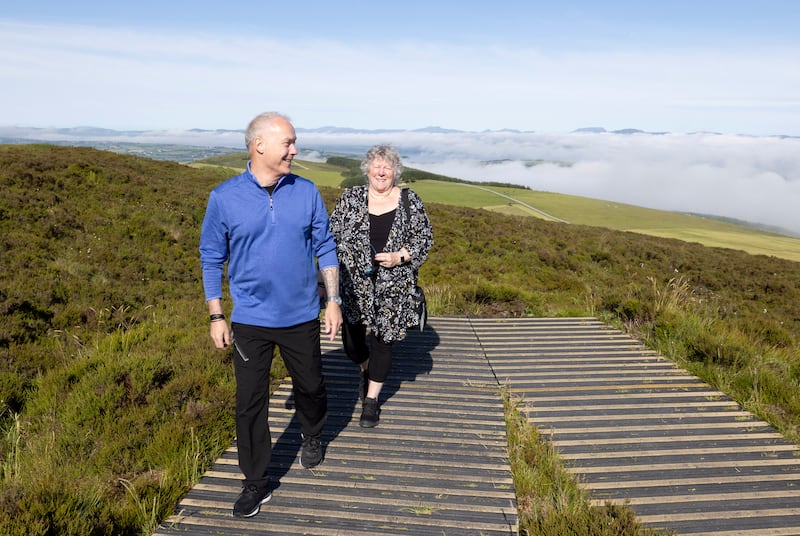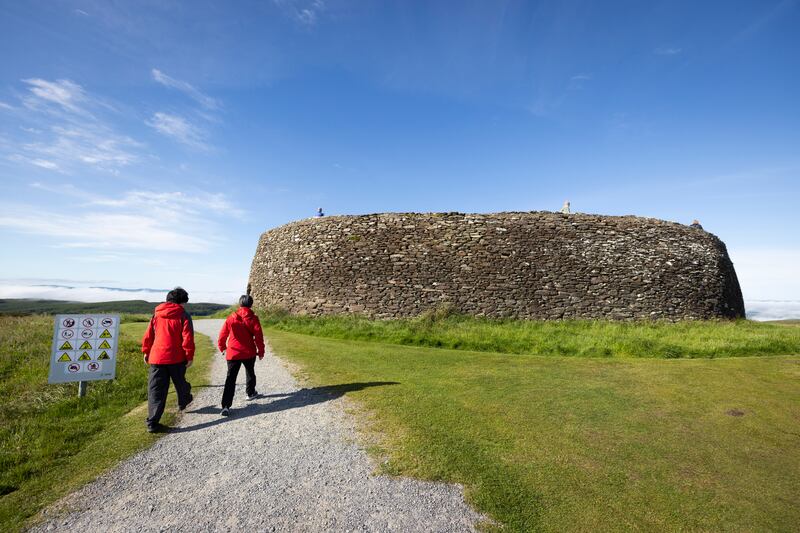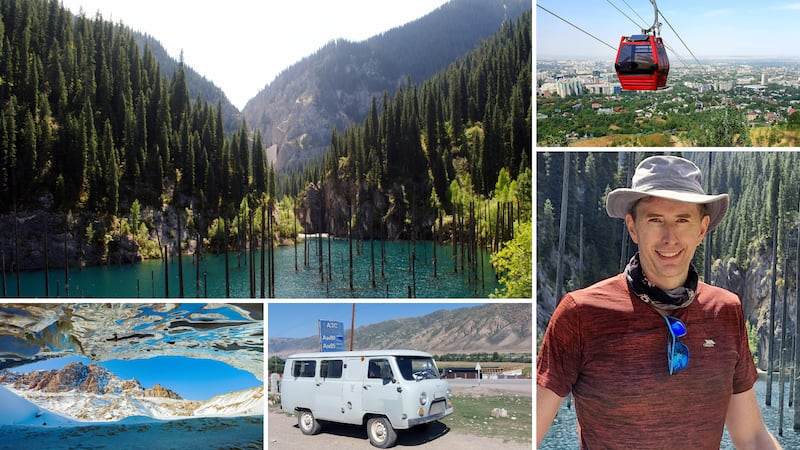“It’s a shuffle of the decks every couple of days. It adds new energy,” Daniel Montgomery says, sitting in a hotel lobby in Derry. Montgomery is both a driver and guide for Paddywagon Tours, and it’s his third season working with them. You’ve probably seen the company’s bright-green buses, featuring a gigantic, chirpy leprechaun, traversing the country.
I had not realised until meeting up with Montgomery partway through a six-day tour that Paddywagon tours are composed of so many moving parts. On the website, what looks like a continuous five-, six- or eight-day tour, can actually be broken down into smaller parts. Some people might be on the tour for the entire time, while others join for only three days or so along the way. It’s the same for the driver-guides. Montgomery joined a tour in Belfast, taking over from a fellow driver-guide who had brought this group from Dublin.
So who is on this tour, for at least the next day, as we travel onwards to Galway? Montgomery consults that day’s roll-call of his ever-changing list of passengers. “Two from China, one from Taiwan, two from LA, two from Canada, two from Cork, one from Tasmania, two from Michigan. Some of those are leaving tomorrow in Galway.”
The main Paddywagon season runs from around St Patrick’s Day into October. “We have all ages and all backgrounds,” he says. In its early days, Paddywagon used to cater for a large cohort of backpackers, who stayed in modest lodgings such as hostels. There is still an option to choose more economical accommodation, but most of their passengers now opt for greater comfort. Tonight, our accommodation is the Holiday Inn Express, where Montgomery is continually greeted by the staff behind the counter, as he is such a regular.
RM Block
I ask Montgomery if his job is made more difficult by having to be both driver and guide. “I don’t have to share tips,” he says, with a laugh, while adding philosophically that “not all people tip. Ireland is an expensive place to travel in, so people have less change in their pockets.”
Why is it Ireland that draws Paddywagon customers? “From talking to people, it’s not like they are looking for their roots or anything. Mostly, it is people looking for time away, and who have found cheap flights to Ireland for certain dates. People book tours like ours with busy schedules because they want to see a lot. If I brought people to the Burren for 10 hours, it wouldn’t work.”

We drive out of Derry at 8.30am the following morning, bound for Galway, via Strandhill in Co Sligo. For passengers doing the whole itinerary, this is day three of six. The remaining two overnights will be spent in Dingle and Killarney, Co Kerry, with a packed schedule for all three remaining days. However, anyone hoping to see “Dingle’s most famous resident, Fungi the dolphin, who we shall have time to visit in the early afternoon”, as described on the website itinerary for day five, is doomed to be disappointed.
Sylvia La Roche from Montreal is travelling with her best friend of 40 years, Roch De Roy. It’s the first time to Ireland for both of them. “We both used to work for the police department, and got to know each other when we went for beers on Fridays,” she says. This is just one of several trips they have made together. De Roy hosts her on each trip, she confides. “We’ve been to Italy, Spain, Portugal, Hong Kong, France, Taiwan and Hawaii. It took me three years to persuade him to come to Ireland.”
The two friends were struck by their time in Belfast, the previous day. “Why is there still a big wall up in the middle of the city, even though the Troubles were meant to be over 25 years ago?” De Roy says, referring to the city’s most famous peace wall marking the interface between the nationalist Falls Road and unionist Shankill Road.
“Seeing Belfast made us value our freedom as citizens,” La Roche says.
As the bus crosses county borders into Co Donegal, Montgomery comes on the intercom. “You will never see a sign that says, ‘Welcome to the Republic of Ireland’ as you cross the Border from Northern Ireland,” he says. “There’s obviously a reluctance to put up that kind of signage. People are quite territorial here.”
We stop at the beautiful circular fort of Grianán of Aileach – or, as Montgomery calls it, “the portal to another world”. We’re the first bus of the day there, the day is bright and clear with huge views, and the Paddywagon passengers are having a genuinely special experience by having the place all to themselves.
Krissy Yang from Taiwan takes selfies at the top of the fort. She is married and has two children at home, but wanted to come to Europe for a couple of weeks by herself. “You can’t read QR codes or Google what you’re seeing when you have small kids with you,” she says. “I studied in London in 2008, but I didn’t come to Ireland then, because people told me it was too dangerous and that there was still a lot of conflict. I also heard Ireland was not a very Asian-friendly place to travel in. And visas were hard to get.”
Yang spent a few days by herself in Dublin before joining the Paddywagon tour. “I thought the houses were very modern. Maybe in the conflict a lot of houses got destroyed?”
Conflict? Does she mean the Troubles, or the Rising?
“The conflict that went on in Ireland,” she says, admitting she’s not quite sure when or where it was. “Everything in Dublin seemed very new. I went to Epic [The Irish Emigration Museum], and I assumed a museum about history would be in an old building, but it wasn’t, which I thought was strange.”

Back at the bus, Montgomery already has the engine running as Yang and I board; the last two to do so. He’s on a tight schedule: the passengers departing at Galway later that day have to meet another Paddywagon tour bus, which will bring them back to Dublin. Just as we leave, several tour buses from other companies start arriving; we have had the best of it.
There’s a quick photo stop at the gorgeous Barnesmore Gap, and as we start getting close to the Leitrim border, Montgomery tells us he is going to play some music. “As we leave Co Donegal, I like to play a song by a man who was born in Donegal, and who didn’t get the success he deserved: Rory Gallagher. He was the musician’s musician. Jimi Hendrix was once asked how did it feel to be the best guitarist in the world, and he said: ‘I don’t know, you’d have to ask Rory Gallagher that question.’”
And then Out on the Western Plain starts playing, to the audible appreciation of all, some of whom, like Yang who is sitting behind me, start googling Gallagher’s name.
At Strandhill in Co Sligo, the waves are crashing on the shore and the wind whips at the pages of my notebook. There’s a lunch stop here, and people go right to the ocean’s edge, as if magnetised, to watch the restless waves.
Mercedes and Agnes Zapata are a mother and daughter from Los Angeles. “My mom knew more about Ireland before we came here than I did,” Agnes says. “All I knew was that there had been conflict; as a kid, I had heard about Bloody Sunday. It was interesting to see art as a form of resistance in Belfast, and at the Bogside in Derry, with all the murals depicting the resistance and a desire for peace. Our driver [Montgomery] described it as an outdoor museum.”
“I thought Belfast looked very like rougher areas in the south of LA,” Mercedes says. “Like a working-class community.”
Husband and wife Ed and Amanda Potchen from Michigan are eating ice creams. It’s Ed’s first time in Ireland, but Amanda studied at UCD for a time, and wanted to show him some of her favourite parts of Ireland, particularly Galway. They’ve been in the country for 10 days. It’s a few years since Amanda has been back in Ireland. “I was very surprised to see so many homeless people,” she says.

She has dreams about getting a job in Galway, and both of them moving there to live for a time. “Ed works in tech, so I’m sure he could get a job there too. My mom visited me when I was studying in Dublin, and she knows why I’d like to stay, but all our family are in Michigan, and she’d rather we stayed there.”
There is another reason holding them back from a possible move to Ireland. Or rather, three of them: Appa, Momo and Izumi, named for characters in Avatar, an animated television series. “We have three chinchillas, and they would have to go into quarantine. Not many people know how to handle chinchillas, so we would be worried about them.”
“They’re a mix between a rabbit and a squirrel,” Ed says. “They live between 15 and 20 years, and we only got them recently, so we might have to wait a while to come to Ireland.”
Back on the bus, we are bound non-stop for Galway. Montgomery plays another song to mark our approach to the City of the Tribes: the Saw Doctors’ N17. He turns the volume up loud, and the lyrics ring out clearly: “I wish I was on that N17/ Stone walls and the grass is green,” as actual stone walls and green fields flash by beyond the windows of the bus.
- Sign up for push alerts and have the best news, analysis and comment delivered directly to your phone
- Join The Irish Times on WhatsApp and stay up to date
- Listen to our Inside Politics podcast for the best political chat and analysis



















